#season 2: central asia
Explore tagged Tumblr posts
Text
Russian Colonialism in Central Asia 1860-1890
From 1860 to 1890, Russia conquered Central Asia. What started as crafting a strong border along their Siberian territories grew into the conquest of most of modern day Central Asia.
Russia and Central Asia have a long, intertwined history that altered between coexistence and conflict. The Russians didn’t start expanding eastwards until the 1500s and they didn’t ’t really consider invading the region until the 1700s and even then, it’s contained to the Steppe lands. We don’t really see engagements with major Central Asian powers until the late 1700s/early 1800s. Their approach isn’t systematic or well planned. The Russians are responding to events unfolding, both in the region and from the around the world, as much as they are trying to shape events to fit their own priorities. They don’t fully subdue the region until the 1880s and roughly 30 years later WWI begins. By 1917 the Tsarist Empire collapses, and Russia loses all control over their conquered territories, including Central Asia. It would be up to the Bolsheviks and the various Central Asian republics to determine what relations would look like during the rest of the 20th century.
Early Russian Incursions (1580s-1700s)
As we mentioned, Russia and the various peoples of Central Asia traded and interacted with each other for most of their early history. The Russians did not consider expanding eastwards until the 1500s, starting with the overthrow of the Kazan khanate in 1552 and Astrakhan khanate in 1556 (two main centers of trade for people from all over the world). In 1580, they overthrew the Khanate of Sibr, opening up Siberia and introducing Kazakh peoples to Cossacks and Slavic merchants, and officials.

Peter the Great
[Image Description: A colored painting of a white man with curly brown hair and a mustache leaning against a chair. Behind him is a grey sky. The man is wearing a dark blue military frock coat with a light blue ribbon and a golden and green metal at his thought. His collar and cuffs are a bright red. He holds a sword with his right hand and a map with his left.]
Up until Peter the Great’s reign in 1682, the Russians and Central Asians spent their time learning about each other and establishing centers of trade. Neither saw each other as a source of danger since the Central Asians khanates were more concerned about fighting each other and resisting pressures from Safavid Iran and China whereas Russia was establishing itself as a state.
It was Peter the Great who turned Russia into an empire and pushed into the Central Asia region, sparking conflict with the Bashirs, Astrakhans, Khiva Khanate, and even Iran. Peter ordered several forts to be built along the current Kazakhstan border and took the Volga and Ural lands, encircling Central Asia. Their first proper incursion into the region was within Steppe lands. The Russians tried to implement tribute and oaths of loyalty, but the Kazakh people either resisted or manipulated Russian demands to fit their needs. They often played the Russians against their other enemies such as China, the Zunghar people, and the different Uzbek Khanates. However, the more involved they became with the Russians, the more restricted their political freedom became and by 1730 they officially asked the Russians for their protection.
Kazakhs and Kyrgyz peoples 1700s-1800s
The first Tsarina to truly interact with her Muslim subjects was Catherine the Great. She chose a position of tolerance while enforcing methods of police control. Catherine believed that if she could use the Islamic hierarchy to manage the people, she could instill law and order in the region. As long as she controlled who was recognized by the state as a legitimate source of religious authority, she could control the people and bind Islamic ideals to the Tsarist system. She implemented this policy with the Muslims in Siberia, the Volga and Ural regions, and the Crimea, utilizing the indigenous Tatars. When Russia tried to implement this system with the Kazakhs they ran into issues.
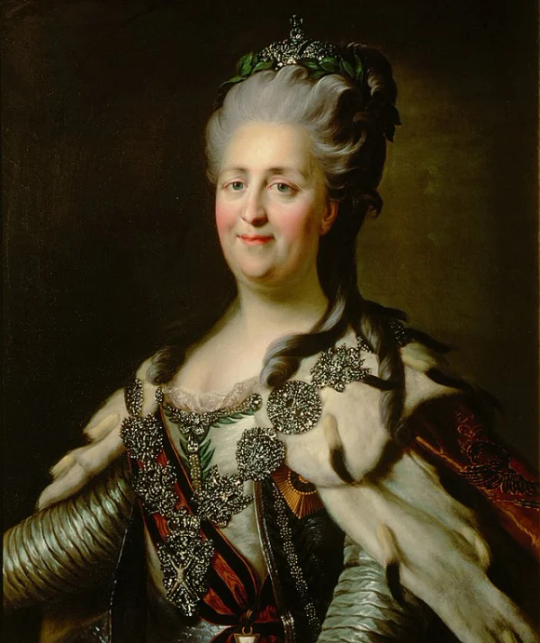
Catherine the Great
[Image Description: A colored painting of a white, big woman with grey hair pinned up and held in place by a golden crown. She is wearing a tan furred dress and a silver necklace with ornaments in the shape of snowflakes.]
Lack of knowledge is a key component in the Russian rule, and they were aware of this. As they incorporated the land, they sent several expeditions into the region to understand the territory, the people, and the benefits they could reap from the area. Ian W Campbell’s book Knowledge and Ends of Empire goes into great detail how much the Russians didn’t know as they conquered the Steppe lands and the efforts, they went through to fill in their knowledge gap.
Since the Kazakhs were nomads, they did not practice a type of Islam recognized by the Russians, so they were unable to utilize any existing religious structure, like they did with the Tatars. Instead, they had to engage with the different tribal leaders and indigenous informers and spies to manage the steppe peoples and enforce a form of sedentary lifestyle (with mixed results).
In an effort to “bring civilization” to the Kazakh people the Russians abolished the hordes and reorganized the land along tribal lines into three regions. They implemented a heavy bureaucracy consisting of auls, townships, and districts. In 1844, the Kazakhs traditional courts were stripped of authority over serious criminal cases and subjected Kazakhs to Russian military courts.
Authority was maintained by the Ministry of Foreign Affairs and military governors, which tried their best to manage the theft and abuse the Kazakhs and Kyrgyz peoples experienced from Russians officials and the Cossacks. This abuse seems to have been driven by the lawlessness common to vast frontiers (one can think of the US’s own Wild West as an example) and because most Russians looked down on the Kazakhs and Kyrgyz as inferior people.
Uzbek Khanates 1800-1900
Driven by mistreatment, starvation, and fear of the Russians, many Kazakh peoples found shelter in the Uzbek khanates. By the 1800s, all three khanates were experiencing civil wars and intense rivalries with each other and either ignored or were disinterested in the Russian encroachment. They were vaguely curious about the increase of British visitors but didn’t seem to realize that it meant trouble for their people. To be fair, the British were notoriously bad at trying to enlist the aid of the khanates as can be seen with the Conolloy-Stoddart-Nasrullah affair.

Nasrullah, Khan of Bukhara
[Image Description: An ink drawing of a man in a turban and long, wispy black beards. He also had a drooping black mustache and a white long dress shirt. The paper the painting is drawn on is tan and below the man are words written in Arabic]
Charles Stoddart was sent to Bukhara by the East India Company to win over the emirate, Nasrullah. Instead Nasrullah found him so insulting, he threw him into a bug pit for a few days. Stoddart remained in Bukhara for three years before the Company sent Captain Arthur Connolly to rescue him. Connolly traveled disguised as a merchant, but the Emirate was on alert since Britain was invading Afghanistan at the same time. Around the time Connolly was arrested, the Afghans organized a revolt that drove the British out of their country (only one British survivor made it back to India). Nasrullah wasn’t impressed and felt even more insulted by Connolly’s and Stoddart’s behavior, so he beheaded them when he caught them trying to smuggle letters to India.
Modern historians have poked several holes into the Great Game narrative, and it may be safe to say that the Great Game is more of a reflection of Britain’s own insecurities and fears than reality (with the Russians taking advantage of said fears). At the same time, Russia was feeling insecure compared to the other European states, had a need to make up for the humiliating defeat suffered during the Crimean War, were concerned about the security of their southern frontier, and held racist beliefs about the inferiority of the Central Asian peoples.
Their first attempt was to invade Khiva in 1839, but that ended in disaster. They would not try again until 1858, pushing southward, along the Syr Darya. By 1860 they had taken and established forts in what is modern day Almaty, Kazakhstan and Bishkek, Kyrgyzstan. In 1864 Colonel Mikhail G. Cherniaev finished the conquest of the land along the Syr Darya by taking the towns of Yasi and Shymkent. In 1865, he took Tashkent from Kokand, conquering the last bit of Kazakh land.
At this point, we can organize the Russian conquest around three major events: the subjugation of the Bukhara and Khiva Khanates, the abolishment of the Kokand Khanate, and the slaughter of the Turkmen people in the Ferghana valley
Conquering the Bukharan Khanate
However, conquering Tashkent dragged them into the rivalry between Kokand and Bukhara. The Russians wanted to turn Tashkent into a buffer state between themselves and Bukhara while Bukhara hoped the Russians would return the city to them. When Emir Muzzafar sent an envoy to embassy to the Tsar, he was arrested and Muzzafar was told he no longer had the right to speak to the Tsar directly. Muzzafar was stunned and furious so he arrested a Russian diplomat sent from Tashkent. The Russians attacked the Bukharan town of Jizza but returned from lack of supplies. The Bukharans responded by marching on Tashkent but were defeated by the Russians at Irjar. The Russians then took Khujand, cutting off communications between Bukhara and Kokand, preventing a coordinated resistance.

Konstantin Petrovich Von Kaufmann
[Image Description: A black and white lithograph of a white man with a receding hairline. He has a grey bushy mustache. He wears a grey military tunic with epaulettes and several medals. His hands rest on his shoulder hilt.]
To neutralized Kokand, further the Russians a treaty with Kokand granting Russian merchants free trade rights in the khanate and vice versa in Russian Turkestan. However, since Russia’s economy was bigger, this made Kokand an economic vassal.
Bukhara tried to resist the Russians but because of a divided military, internal rebellions, and antiquated technology, Muzzafar was forced to surrender in June 1868. The treaty restored Muzzafar’s sovereignty but took Samarkand away, controlling Bukhara’s main water source. Russian merchants were allowed to conduct business in Bukhara with the same rights as local merchants and Bukhara had to pay a compensation for Russia’s expenses during the war.
While the conquest of the Syr Darya basin and Tashkent had been approved by ministers in St. Petersburg, the Bukharan conflict was decided by officers on the ground. They actually recalled Cherniaev in 1866 only for his replacement, Romanovskii to attack Khujand. In 1867, Romanovskii was replaced by Konstantin Petrovich Von Kaufmann (who was a bit of an asshole) who served as Turkestan’s first governor-general. Despite the fact that its military had gone rogue, the Russians could not tolerate retreating or returning the land. Think about how it would affect its standing amongst the European powers (sarcasm)
Kaufman called his conquered territory Turkestan and made Tashkent as its capital. Given its distant from St. Petersburg, Kaufman enjoyed remarkable independence and was more like an emperor than a civil servant.
Conquering the Khivan Khanate
By 1859, Russia had conquered the North Caucasus and created a port in modern day Turkmenboshi, Turkmenistan. This allowed the Russians to transport goods via the river, instead of making the long and dangerous journey from Khiva to Orenburg. This deeply hurt Khiva’s income and cut into the incomes of the Turkmen who protected or raided the traveling merchants.
That, combined with the Russian conquest of Kokand and Bukhara and Khiva was in serious trouble. Khivan Emir Muhammad Rahim, learned from Bukhara, released all Russian prisoners, and negotiated with Russia for peace. Kaufman, however, wasn’t interested in peace. Instead, he sent message after message to Alexander II to complain about Khiva’s insolence and the danger it posed to Russian merchants, finally getting his permission to launch a military campaign to punish Khiva. In 1872, Kaufman led an invasion of four columns, consisting of over 12,000 men and tens of thousands of camels and horses and attacked Khiva from three directions. The Khivans did not resist vigorously whereas the Turkmen fought viciously.
On June 14th, Muhammad Rahim surrendered and Kaufmen forced him to govern under a Russian led council while he ransacked the palace for personal prizes. On August 12th, 1873, Rahim signed a stricter treaty then the one Muzzafar signed. The treaty forced the khan to acknowledge he was an obedient servant of the Tsar, granted control of navigation over the river Amu Darya to the Russians, and granted extensive privileges to Russian merchants. They also agreed to pay Russian 2.2 million rubles over the course of twenty years.
The Turkmen
While Khiva was subdued, the Turkmen were as rebellious as ever and Kaufman jumped at the opportunity to expand his power and earn more “glory”. In July 1873, he required that the Turkmen pay 600,000 rubles with only two weeks to deliver, knowing it would be impossible to do. When they failed, Kaufman launched an attack on the Yomut, a Turkmen tribe. American journalist Januarius MacGahan reported the following:
This is war such as I had never before seen, and such as is rarely seen in modern days…I follow down to the marsh, passing two or three dead bodies on the way. In the marsh are twenty or thirty women and children, up to their necks in water, trying to hide among the weeds and grass, begging for their lives, and screaming in the most pitiful manner. The Cossacks have already passed, paying no attention to them. One villainous-looking brute, however, had dropped out of the ranks and leveling his piece as he sat on his horse, deliberately took aim at the screaming group, and before I could stop him, pulled the trigger. Fortunately, the gun missed fire, and before he could renew the cap, I rode up and cutting him across the face with my riding-whip, ordered him to his sotnia. - Januarius MacGahan
By end of July, the Turkmen agreed to pay and Kaufman extended the deadline.
Even though Russian conquered Kokand, they had a hard time implementing political control, having to deal with a still strong khanate and an angry populace. The death of the old khan, Alim Qul, allowed Khudoyar Khan to return to rule. However, his close ties with Russia inspired a revolt amongst the Kokandi Kyrgyz nobles who drove him out in August 1875. The Russians placed his son, Nasruddin on the throne, but another revolt drove him out as well and Russia was stuck with a region deep in civil war with no clear factions.
Kaufman, worried that Bukhara or the British would take advantage, launched another military campaign. This campaign was particularly bloody, with Major-General Mikhail D. Skobelev making it a point of murdering civilians to crush all future rebellions. Vladimir P. Nalivkin, a young officer serving under Skobelev wrote the following of an incident where Skobelev ordered his Cossacks to charge fleeing civilians while their divisional commander countermanded the order. He then told Nalivkin to chase after a Cossack bearing down on an unarmed man carrying his child. Nalivkin wrote the following:
“With a cry “leave him alone! Leave him alone!” I rushed towards the man (sart), but it was already too late: one of the Cossacks brought down his sword, and the unfortunate two or three-year-old child fell from the arms of the dumbfounded, panic-striken man, landing on the ground with a deeply cleft head. The man’s arms were apparently cut. The bloody child convulsed and died. The man blankly stared now at me, now at the child, with wildly darting, wide eyes. God forbid that anyone else should have to live through the horror I lived through in that moment. I felt as though insects were crawling up my spine and cheeks, something gripped me by the throat, and I could neither speak nor breathe. I had seen dead and wounded people many times; I had seen death before, but such horror, such abomination, such infamy I had never been seen with my own eye: this was new to me.” - Vladimir P. Nalivkin
The war ended in 1876 with the bombing of Andijan, which Skobelev described himself as a pogram. Kaufman abolished the Kokand Khanate on February 19th, the same day as the anniversary of Alexander II’s ascension to the throne. He renamed the region the Ferghana District and named Skobelev its governor.
Finally, the Russians finished their conquest by subjugating the Turkmen Tekke tribes who lived around the oases in the Qara Qum desert. The reason for the attack was geopolitical. The Russians had won a war against the Ottoman Empire in 1878 but the British prevented the Russians from seizing Constantinople, so Kaufman was ordered to march on India.
Kaufman sent three columns towards Afghanistan and Kashmir and a fourth column heading towards the town on Kelif on the Amu Darya. To get there, they had to march through Tekke Turkmen territory. The attack was called off a week later, but the Russians continued south to establish a line of forts on the border of Iranian Khurasan. These forts were vulnerable to Turkmen attack, so the Russians laid siege to the town of Gok Tepe.
Their artillery was devastating but the Russians were defeated by fierce Turkmen fighting when they decided to storm the town. Skobelev led a revenge campaign in November 1880, finally blowing up the walls of Gok Tepe in January 1881. He ordered the Cossacks to pursue and kill anyone fleeing. The total cost was 14,500 Turkmen killed, including many non-combatants, destroying the Tekke Turkmen for decades and finalizing Russian control over Central Asia.
References
For Prophet and Tsar: Islam and Empire in Russia and Central Asia by Robert D. Crews Published by Harvard University Press, 2006
The Rise and Fall of Khoqand: Central Asia in the Global Age 1709-1876 by Scott C. Levi Published by the University of Pittsburgh Press, 2017
The Bukharan Crisis: a Connected History of 18th Century Central Asia by Scott C. Levi Published by University of Pittsburgh Press, 2020
Tatar Empire: Kazan’s Muslims and the Making of Imperial Russia by Danielle Ross Published by Indiana University Press, 2020
Russia and Central Asia: Coexistence, Conquest, Coexistence by Shoshana Keller Published by University of Toronto Press, 2019
Russia’s Protectorates in Central Asia: Bukhara and Khiva, 1865-1924 by Seymour Becker, Published by RoutledgeCurzon, 2004
Tournament of Shadows: the Great Game and the Race for Empire in Central Asia by Karl E. Meyer and Shareen Blair Brysac Published by Basic Books, 1999
#Season 2: Central Asia#Central Asia#Central Asian History#Russian Colonialism#Podcast Episode#Blog Post#history blog#queer historian#queer podcaster#Spotify
9 notes
·
View notes
Text
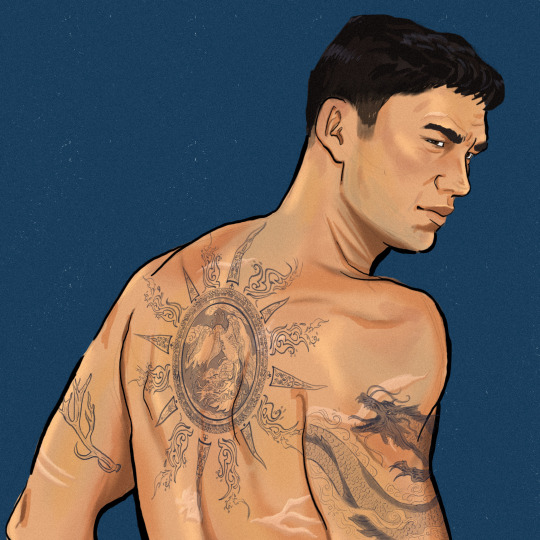

the @gvartistsforpalestine commission said, "mals tattoo and part of his face"
I really enjoyed drawing on motifs from Southeastern Russian (including Slavic motifs and groups like the Shor), Mongolian, Kazakh, and northwestern Chinese art and embroidery for this design. Mal's background (even whether he knows his parents or not) isn't explored in the show, even at times it was deeply weird for it not to come up--like meeting the twins with Alina, or when he and Alina discuss their relationship to the Ravkan regime 🥴🤔. Yet season 1 clearly shows and implies Mal is somehow "other" like Alina, but is more ethnically ambiguous and presumably able to dodge some of the racism she gets. Therefore I made the designs on the theory that he, like Alina, is either half Shu or from a border area where the distinction is inapplicable.
That being said, I think show!Mal being half Suli would be very interesting. It is the analog to Archie Reneaux's background (in the sense that it appears south Asian actors are being cast for the Suli).
#grishaverse#mal oretsev#malina#shadow and bone#shadow and bone fanart#shadow and bone season 2#save shadow and bone#shadow and bone season 3#six of crows spinoff#grishaverse fanart#malina fanart#mal fanart#tattoos#kazakh#russian#mongolian#central asia fantasy inspo#tattoo artist#drawing#illustration#doodles#my doodles#art#my art#procreate
76 notes
·
View notes
Text

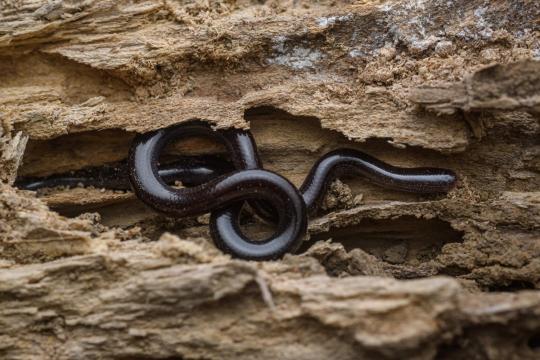

Brace Yourself for the Brahminy Blind Snake
Also known as the flowerpot snake, the Kurudi snake, or the Sirupaambu snake, the Brahminy blind snake (Indotyphlops braminus) is a species of snake common throughout Africa and southern Asia, and introduced in southern Europe, southern North America and Central America, and parts of Oceania including mainland Australia.
The Brahminy blind snake is a fossorial species, spending most of its time underground or in piles of dense leaf litter in forests and agricultural areas. During the winter in colder regions, they burrow deep beneath the earth and enter a state of hibernation. They are not aggressive or venomous, and feed mainly on eggs and insects, especially ants and termites. As a result they are often found near anthills or termite mounds. The kurudi snake can be predated upon by larger snakes, amphibians, birds, and some carnivorous insects.
I. braminus is the smallest recognized snake, ranging only 5–10 cm (2-4 in) in length and weighing between 0.74-1.87 g (0.02-0.06 oz). Due to their burrowing nature, they are also quite slender, and their head is as narrow as the rest of their body. The tail is distinguishable only by a small, sharp spur. The eyes are extremely small and can only register light. Adults are typically dark gray or brown, although they can become beige or purple while molting.
The flowerpot snake reproduces entirely via parthenogenisis, a mechanism in which the mother's eggs duplicate via mitosis. The result of this method of reproduction is that offspring are all clones of their mother. In the spring Females may either lay eggs or give birth to live offspring, up to eight at a time. Young emerge shortly before monsoon season and are are capable of fending for themselves immediately after being born.
Conservation status: the IUCN has ranked the Brahminy blind snake as Least Concern due to its wide distribution. Although it has been introduced to many areas outside its native range, it is not considered ecologically damaging.
Photos
Gulab Khedkar et al.
Vijay Anand Ismavel
Thai National Parks
#brahminy blind snake#Squamata#Typhlopidae#blind snakes#snakes#serpents#squamates#reptiles#tropical forests#tropical forest reptiles#urban fauna#urban reptiles#africa#asia#animal facts#biology#zoology#ecology#queer fauna#nature is queer
350 notes
·
View notes
Text
Infographic I made awhile back.

ID start 3 images of a light grey/tan fox in different poses line the top, it is a Corsac fox. Text at top says "Vulpes corsac Aka Coraac fox, Corsac".
Below that is an image depicting the rage of the Corsac fox. Beside it to the left text reads "Corsac foxes live in the central and northeast
Asia. They are found throughout Kazakhstan, Uzbekistan, and Turkmenistan, and throughout Mongolia, except the northernmost regions. In the south, their range extends into the more northern parts of Iran, Tajikistan, Kyrgyzstan, Afghanistan, and China, and they can also be found in neighboring regions of Russia." Underneath the text is another image of a small rodent, it is brown/tan and stands on it's thin hind legs with short front arms. Text beside that reads "Corsac foxes are omnivorous, out mostly with carnivorous tendencies. Their diet is mainly of insects and small rodents, such as voles, gerbils, jerboas, hamsters, and ground squirrels. Sometimes they may also occasionally eat larger prey, including hares and pikas, and will scavenge for carrion and human refuse.
On occasion they eat fruit and other vegetation, mainly when prey is hard to come by. As an adaption to their environment, Corsacs need little water to survive, gaining most of the water needed from the food they eat." Underneath the text is another image of a Corsac fox in it's summer coat, it is a darker grey. Text beside that reads "Corsac foxes mating behaviour is monogamous, they form pair bonds. Before they bond though, males will initially fight for access to females. Their mating season is from January to March. Females create birthing dens and will occasionally share it with others pregnant females with their gestation period at 52-60 days. The maximum litter recorded is 11 kits, they weigh about 60 g (2.1 oz) when born and have fluffy, light brown fur that turns yellowish as they get older. They are blind until about 2 weeks of age. Both the female and the male of the pair assist in raising the kits. The young begin to eat at about 4 weeks and emerge from the den shortly after. They reach reproductive maturity at about 9
to 10 months, but don't reproduce until the second year of life. Their main threat is humans, however they are Least
Concern with population." ID end
#fox facts#foxes#fox#fox information#animal facts#my post#special interest#vulpes#infographic#fact of the week#fun facts#facts#random facts#interesting facts#science facts
85 notes
·
View notes
Text
Round 2.5 - Cnidaria - Scyphozoa

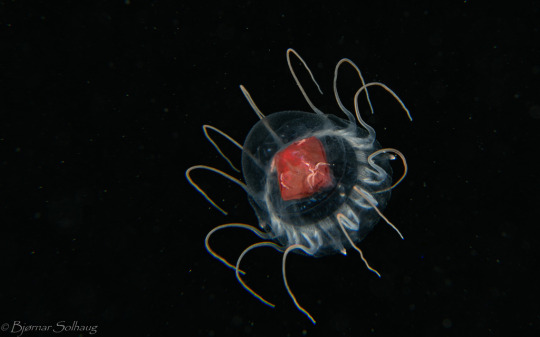
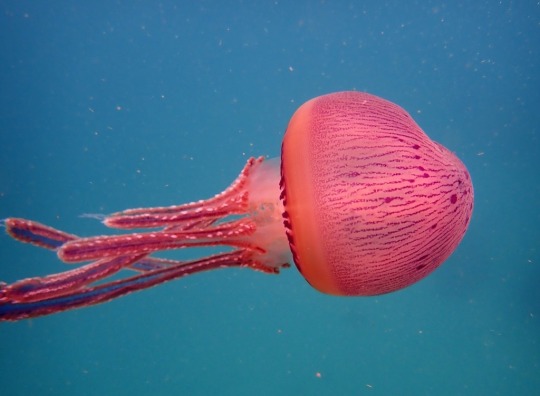

(Sources - 1, 2, 3, 4)
Scyphozoa is a marine class of cnidarians commonly referred to as “true jellyfish”, “jellyfish”, or simply “jellies”. They are composed of three living orders: Coronatae (“Crown Jellies”), Rhizostomeae (“Root-mouth Jellies”), Semaeostomeae (“Flag-mouth Jellies”).
Scyphozoans usually display a four-part symmetry and have an internal gelatinous material called mesoglea, consisting of as much as 98% water. A ring of muscle fibres within the mesoglea surrounds the rim of the dome, and the jellyfish swims by alternately contracting and relaxing these muscles. As medusae, they eat a variety of crustaceans and fish, which they capture using stinging cells called nematocysts. The nematocysts are located throughout the tentacles that radiate downward from the edge of the umbrella dome, and also cover the four or eight oral arms that hang down from the central mouth. Some species, however, are instead filter feeders, using their tentacles to strain plankton from the water. The mouth opens into a central stomach, from which four interconnected diverticula radiate outwards. Some genera also have smaller mouths in the oral arms. The lining of the digestive system includes further stinging nematocysts, along with cells that secrete digestive enzymes. The nervous system usually consists of a distributed net of cells, although some species possess more organised nerve rings. Some species also have pigment-cup ocelli, though they are not as advanced as Cubozoan eyes. Coronataens (ex: image 2) are characterized by a deep groove running around the umbrella, giving them the crown shape which gives them their name. Rhizostomeans (ex: image 1 and 3) do not have tentacles nor other structures branching off from the edges of the bell. Instead, they have eight highly branched oral arms which fuse together as they approach the central mouth of the jellyfish. Semaeostomeaens (ex: image 4 and gif below) have four long, frilly oral arms flanking their quadrate mouths, as well as tentacles.
Most species of Scyphozoa have two life-history phases, including the planktonic medusa or polyp form, and the inconspicuous, but longer-lived, bottom-dwelling polyp, which seasonally gives rise to new medusae. Most species appear to be gonochorists, with separate male and female individuals. The gonads are located in the stomach lining, and the mature gametes are expelled through the mouth. After fertilization, some species brood their young in pouches on the oral arms, but they are more commonly planktonic. The fertilized egg produces a planular larva which, in most species, quickly attaches itself to the sea bottom. The larva develops into the hydroid stage of the lifecycle, a tiny sessile polyp called a scyphistoma. The scyphistoma reproduces asexually, producing similar polyps by budding, and then either transforming into a medusa, or budding several medusae off from its upper surface via a process called strobilation. The medusae are initially microscopic and may take years to reach sexual maturity.
Scyphozoans have existed since the Early Cambrian.
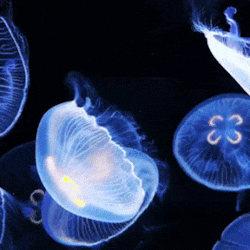
Propaganda under the cut:
The Lion’s Mane Jelly (Cyanea capillata) is one of the largest jellyfish, with the largest recorded specimen having a bell width of 210 cm (7 ft) and tentacles around 36.6 m (120 ft) long.
Jellyfish of the order Rhizostomeae are considered edible, both as a delicacy and for use in traditional medicine, and are eaten mainly in Asia, typically dried and/or salted.
The giant Nomura's Jellyfish (Nemopilema nomurai) can reach similar sizes to the Lion’s Mane Jellyfish, and their large size and quantity often negatively affects fisheries in East Asia. Aside from humans, their only predators are swordfish, tuna, sunfish, and leatherback sea turtles. A decrease in predators and an increase in favorable conditions and warming seas have caused an explosion in population, displaying that an increase in animal populations is not always a good sign! Scientists are studying their venom for use in medical applications, such as for treating joint disease and in cancer research. The Japanese company Tango Jersey Dairy also produces a vanilla and jellyfish ice cream using Nomura's Jellyfish.
While most jellies are exclusively marine, the Bay Nettle (Chrysaora chesapeakei) ventures into the Chesapeake Bay’s brackish water all the way up into the freshwater of Baltimore’s Inner Harbor.
The Giant Phantom Jelly (Stygiomedusa gigantea) is a deep sea jellyfish that is rarely seen, with only around 110 sightings in 110 years. It thought to be one of the largest invertebrate predators of the ocean's midnight zone and twilight zone, with an umbrella-shaped bell that can grow up to 1 m (3.3 ft) in diameter and paddle-like arms that can grow up to 10 m (33 ft) in length. The bell's pliant tissue allows for the jellyfish to stretch 4 to 5 times its size, presumably to engulf their prey. They do not have any stinging tentacles and instead use their arms to trap and engulf their prey which consists of plankton and small fish. The Giant Phantom Jelly has a symbiotic relationship with the Pelagic Brotula (Thalassobathia pelagica), for which it provides food and shelter beneath its massive billowing bell, while the fish aids the jelly by removing parasites.
The Mauve Stinger (Pelagia noctiluca) is a fairly small purple jellyfish that is able to glow in the dark (bioluminesce). Light is emitted in the form of flashes when the medusa is stimulated by turbulence created by waves or by a ship's motion. Unusually among cnidarians, Mauve Stingers are able to consume phytoplankton, alongside copepods and other usual planktonic fare.
The Moon Jelly (Aurelia aurita) (see gif above) is gaining popularity in aquarium touchtanks as they lack long tentacles and their sting has little to no affect on humans. They are also one of the longer-lived jellyfish, living up to two years in their medusa form, and are easy to rear and feed, making them a good candidate for giving humans an up-close learning experience with jellies.
Fun fact: my dad let me watch The Sphere (1998) when I was 7 and it gave me Scyphophobia, a fear of jellyfish, that lasted for several years. I knew the behavior of the jellyfish as depicted in the movie wasn’t real, but I still wouldn’t enter the ocean for the next 5 years, and when I did start entering the ocean again every time I saw a jellyfish I would get out and not go back in again for another full year. It took a touch tank and several positive experiences with some moon jellies to get over my fear, and now I would say I’m fully recovered!
99 notes
·
View notes
Text
I mean both systems exist so we're both right ¯\_(ツ)_/¯
A lot of people also just go by the first of the month I think, so winter would've started two weeks ago.
It is so bleeding cold
It’s not even midwinter yet
#ooc. mun genq about which cultures consider solstice the beginning of the season#<- mostly central Europe#apparently#(I had to look it up)#the Nordics use the solstices and equinoxes as midpoints#same for parts of Asia#couldn't find anything for Southern or Eastern Europe#or anywhere else#but it also just seems to change#depending on the individual person you ask#idk seasons are confusing#for where I live going by solstice and equinox gives the best approximation to the seasons#(we get first snow in early december for a few days then no snow till january and last snow days are like march or even april)#but we don't get continous snow coverage it always melts after a few days so like 90% of winter there isn't any snow#so most of the time it is simply Cold Dark Wet and Grey#sorry I'm getting only 7 1/2 hours of daylight rn and am grumpy about it lol#also fun fact white easter is actually way more common than white Christmas#anyway#why do people live here!!!!#and yet#I could never leave#it's stockholm syndrome I'm tellling you xD
10 notes
·
View notes
Text
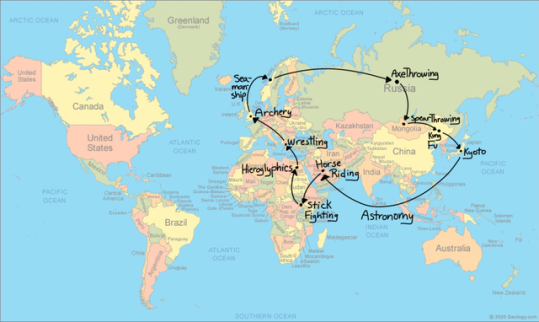

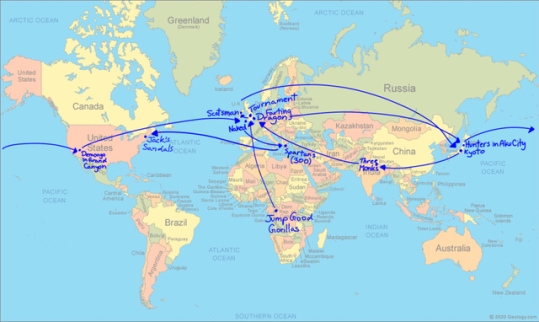

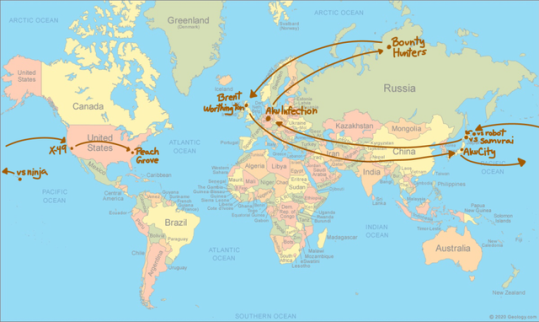
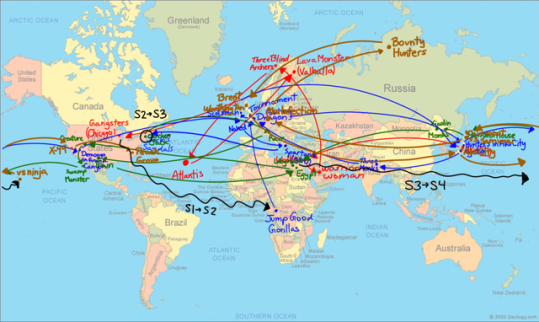
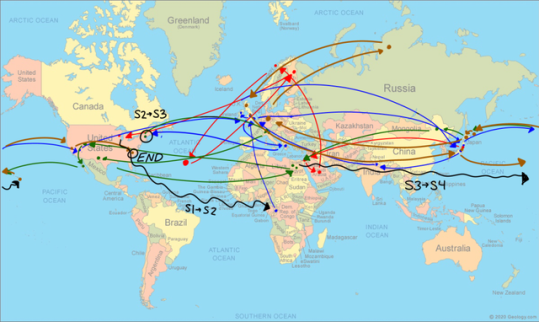
My brother and I rewatched the original run of Samurai Jack and I made a road map of all the places traveled Jack to on his journey. I've written all the explanations to where I placed the markers down below.
Season 1:
Ep 1: The Beginning - takes place in ancient Japan. I placed the marker in Kyoto because that was Japan's capital before Tokyo, but it could be anywhere in ancient Japan. From there, young Jack traveled across the Indian Ocean, Africa, Europe, the Middle East, and Asia to learn new skills.
Ep 2: The Samurai Called Jack - Jack arrives in the future in what I dubbed "Aku City". Since Jack fought Aku in Japan, I placed this new "Aku City" in place of Tokyo, Japan. Again, it could be anywhere, but I thought the bustling city was appropriate as a substitute for Tokyo.
Ep 3: The First Fight - Not marked on the map, because the dog mining canyon is too vague and didn't have any distinct land marks.
Ep 4: The Woolies and the Chritchellites - The Woolies are shown to be wearing kippot in their flashback, so I placed them in Isarel.
Ep 5: Jack in Space - Not marked on the map, because half of this takes place in space. And the woods were too vague to be any specific location.
Ep 6: The Warrior Woman - takes places in Saudi Arabia because of the marketplace and desert landscape, and all the musical references as well.
Ep 7: The Three Blind Archers - The army that attacks the three blind archers at the beginning of the episode are heavily based on Nordic Vikings, so I placed it in Norway.
Ep 8: Mad Jack - Not marked on the map, too vague.
Ep 9: Under the Sea - Jack goes to Atlantis, which is somewhere in the middle of the Atlantic Ocean.
Ep 10: The Lava Monster - The lava monster is a Viking warrior trapped under a curse, connected by his longing to go to Valhalla, so it is another case of Viking mythology, which could be from Norway, Sweden, or Finland.
Ep 11: The Scotsman - Not marked on the map, because the Scotsman was also travelling in a vague landscape.
Ep 12: The Gangsters - The gangsters have Chicago accents.
Ep 13: Aku's Fairy Tales - Takes place in Aku City, but not marked on map because this episode is not about Jack.
Season 2:
Ep 1: Jack learns to Jump Good - Gorillas are most commonly found in Central Africa, specifically the Congo.
Ep 2: Jack's Tales - Not marked on the map, because it is three different stories that don't have any specific location.
Ep 3: The Smackback - The announcer for the tournament is very British, from his attire to his accent.
Ep 4: The Scotsman 2 - The Scotsman invites Jack to his home in Scotland to visit his family, and to save his wife. This episode was pretty self-explanatory.
Ep 5: The Ultra-Robots - Not marked on the map, because the scientists did not have any specific characters traits to draw from.
Ep 6: Jack Remembers the Past - Jack returns to the ruins of his home. Since I placed his home in Kyoto, I marked it as Kyoto.
Ep 7: The Monks - The cartoon idea of climbing a mountain to overcome a big challenge in life is usually associated with the tallest mountain in the world, Mount Everest which is located in Nepal.
Ep 8: The Farting Dragon - The village are all very ole-timey British stereotypes. Also, the dragon is a typical depiction of a European dragon.
Ep 9: Versus the five Hunters - The Hunters are summoned from another planet by Aku, but the episode takes place in a bustling city. And since Aku summoned them to the city himself, it is implied to be Aku City.
Ep 10: Demongo, the Soul Collector - The fight between jack and Demongo takes place in a large canyon, so I marked it as the Grand Canyon. It's possible that it's not, but there are not many known canyons and the place they seemed to fight in was pretty large.
Ep 11: Jack is Naked - This episode is a parody of Alice in Wonderland, which takes place in England. Also, the underground city is filled with English accents and jobs (like the cop looking like a stereotypical British police officer).
Ep 12: The Spartans - This episode is a parody of the War of 300, which took place in Greece.
Ep 13: Jack's Shoes - I originally had this placed in Aku City again, but my brother convinced me to place it in New York instead. The different cultures we see mixed and mingled is different than what we see in Aku City. And the Japan car shop is like an immigrant family making a new life, but still holding onto their tradition- which is much more like New York than Tokyo.
Season 3:
Ep 1: Chicken Jack - The bustling city mixed with the emphasis of different cultures (the Japanese food vendor, the Italian man, the gangsters), are more reminiscent of New York.
Ep 2: The Rave - The Innkeeper Jack spoke to at the beginning of the episode had an Italian accent and wore Italian clothing.
Ep 3: Couple on a Train - The assassins in this episode had heavy Texas accents.
Ep 4: The Zombies - Not marked on the map, since this episode takes place in a graveyard, which could be anywhere.
Ep 5: The Scarab - The episode opens with Jack reminiscing about his time in Egypt as a kid, as he explored the ruins. This episode also features Set's servants and the Egyptian God Horus.
Ep 6: The Traveling Creatures - Not marked on the map, the places jack traveled to were fantastical and not any real landmarks were shown.
Ep 7: The Annoying Creature - The dried cracked mud resembled Nevada's landscape.
Ep 8: The Swamp Wizard - Aku, disguised as a swamp wizard, puts on a Mexican accent to blend in?
Ep 9: The Haunted House - somewhere in Japan, as the house Jack travels to has ancient Japanese architecture, and the residents of the house were Japanese. Also, the spirit haunting the house could be called a yokai.
Ep 10: Jack travels and meets two monks that were taught the same Xiaolin moves as him long ago, so it is implied that Jack returned to the same palace where he first learned kung fu.
Ep 11+12: The Birth of Evil - Not marked on the map, because it is a flashback episode
Ep 13: The Labyrinth - Jack travels to the Egyptian pyramids in order to find a diamond that can help him return home.
Season 4:
Ep 1: Versus the Ninja - Jack helps a village of natives on the coast, who have stereotypical straw huts and tiki masks on the side.
Ep 2: Robo-samurai vs Mondo-bot - This episode didn't have any specific landmarks to reference, but the episode is a parody of Godzilla movies, so I placed it in Japan.
Ep 3: Samurai vs Samurai - The bar that Jack visits has a Japanese design, it is the middle of a bamboo forest, and one of the patrons of the bar is a geisha- a Japapnese female entertainer.
Ep 4: The Aku Infection - Jack is traveling through snowy mountains, one of the mountain researchers have a German accent. Also, the salamander monks have a specific Jewish accent, which is found in Germany.
Ep 5: The Princess and the Bounty Hunter - This episode takes place in a very snowy landscape, and this is the first time in the series we have had a Russian accent. It's possible that this episode could take place anywhere that is snowy (and the barbershop haircutter had an Italian accent), but the fact that this is the one and only time we had a Russian show up, I marked it in Russia.
Ep 6+7: The Scotsman Saves Jack - Jack has a new identity as Brent Worthington, he wears British clothing but speaks with a California/beach bum accent. Since Jack had to get those clothes from somewhere, and sirens are typically a European myth, I marked this episode in the UK.
Ep 8: The Flying Prince and Princess - Two members of an alien royalty are taken to Aku, where Jack was planning to ambush him. Wherever Aku is, I mark it as Aku City.
Ep 9: Jack vs Aku - Not marked on the map, because my brother convinced me it was too vague of a setting. My guess would have been Greece because of the ruins of pillars and large cement floors.
Ep 10: The Four Season of Death - Not marked on the map, because it is an anthology episode that doesn't taken place anywhere specific.
Ep 11: Tale of X-49 - the wiki said it's a parody of Blade Runner with some reference to John Wick. Blade Runner takes place in Los Angeles, so that's where I marked it.
Ep 12: Young Jack in Africa - not marked on the map, because it is a flashback episode
Ep 13: The Baby - The baby is found and returned to the peach grove by Jack. The most popular/biggest peach grove I could find was in Georgia, USA so???
8 notes
·
View notes
Text
now that the drivers are talking about the strain that travel put on them and especially their teams this year, it would be a good idea to look at the 2024 f1 calendar


above is the 2024 schedule with an accompanying flight map i drew. there are so many races, too many to be honest, and the flight map is insane. there is so much backtracking over continents and the constant time changes is sure to take a toll on everyone who is travelling.
considering that the fia is not very likely to cut down on the number of races, i have proposed a hypothetical calendar for next year that is more eco friendly and more travel friendly for the drivers at their teams

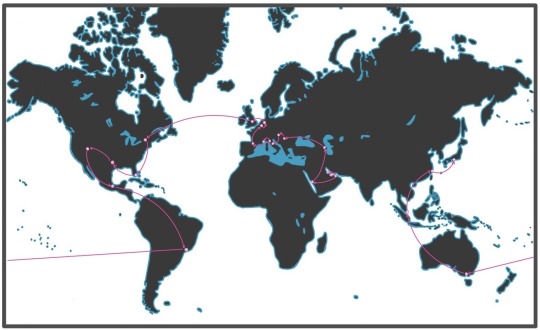
there are a few things i considered
1. climate
the climate in some races means you can't just move them anywhere, but im pretty sure that this accommodates for all the climates that would effect f1
2. location & travel
obviously this takes into account travel by grouping similar locations together. this reduces the environmental impact of so much travel as much as possible, and is easier on people's bodies especially for those team members who aren't drivers travelling in private jets or first class. another reason i like this is that it means that they are in the middle east for the first two months of the season, and then they are in europe until the last full weekend in august. this allows them to spend more time with their families from march until august as they are close to where most drivers live with their families in central or western europe.
3. equipment
not to get into specifics but i was looking into how they transport the spare car parts and the pits themselves, and how it works right now is usually there's an asia/australia cargo ship, an americas cargo ship, and a middle east cargo ship for out of europe races. the way this schedule works out is the ships can move back and forth between places without sticking to this schedule but still getting there in time (i have more thoughts on this i can elaborate if necessary)
things i consider to be hinderances:
1. start/end races
obviously it's still starting in the same place in bahrain but i didn't end it in abu dhabi. of course this is easily fixed by just putting abu dhabi after suzuka, although that's a rough journey
2. brazil to australia
the other thing is that there is a double header that ends up being brazil to australia, but this can be fixed again by moving mexico city and brazil back by two weeks so the break in the fall happens between brazil and australia instead of vegas and mexico on the adjusted calendar
this will never happen, the fia doesn't care about it's drivers and their teams, but i can dream right?
61 notes
·
View notes
Text
Dandadan Episode 12 Preview: Season 1 End with a Huge cliffhanger? What to expect Next

The season finale of Dandadan is here! Episode 12, the last episode of Season 1, is set to deliver high stakes, emotional drama, and thrilling action as Momo Ayase, Ken “Okarun” Takakura, and Jin “Jiji” Enjoji face a supernatural challenge that could change everything. Dandadan Episode 12 Release Date and Time The final episode of Dandadan Season 1 airs on Thursday, December 19, 2024, at 7:30 a.m. PT. Here’s the full schedule for international viewers based on time zones: Time ZoneRelease TimeJST (Japanese Standard Time)11:30 p.m.GMT+8 (Southeast Asia)10:30 p.m.ET (Eastern Time)10:30 a.m.CT (Central Time)9:30 a.m.GMT (Western Europe)2:30 p.m.CET (Central European Time)4:30 p.m.IST (Indian Standard Time)8:00 p.m.
What to Expect in Dandadan Episode 12
Episode 12 promises an explosive conclusion to Season 1, where the trio faces the consequences of Jiji’s supernatural curse. With a dangerous spirit involved and their love triangle adding tension, the group must confront their challenges and protect each other in this action-packed finale. Enjoy the preview of Dandadan Season 1 Final Episode. The episode 12 is titled "Let's Go to the Cursed House". https://youtu.be/KR6qd8zvk-0?si=d-4y-COJZ7dlhh7E Credit: Science Saru Spoilers Ahead Jiji’s Introduction Marks the Start of The Cursed House Arc in Dandadan The fourth arc of Dandadan, known as The Cursed House Arc, kicks off with Jiji’s introduction. Spanning 23 chapters, it’s unlikely the anime adaptation can cover the entire arc in just two episodes, as the series typically adapts around three chapters per episode. This makes it clear that the first season will conclude abruptly, leaving fans with unresolved questions. Fortunately, rumors of Dandadan Season 2 suggest fans might not have to wait long before delving further into the mysteries of the cursed house. The international manga anime convention Jump Fiesta 2025 will run from Friday, December 20 to Sunday, December 22 in Tokyo, Japan. Dandadan has been confirmed to appear at this event. The Cursed House Arc: Dandadan’s Most Intense Storyline Yet In The Cursed House Arc, Momo and Okarun are drawn to a mysterious house in a remote village where Jiji and his family are grappling with strange misfortunes. Jiji is convinced that an evil spirit resides in the house and asks Momo for help in exorcising it. Okarun joins the mission, though Seiko, whose powers are bound to Kamikoshi City, would have been the better choice for such a task. However, the situation is far darker than the trio expects. The village is controlled by the Kito family, Jiji’s landlords, who harbor sinister secrets. They attract tenants with low rents only to use them as sacrifices for Tsuchinoko, a being they worship as a local deity. A hidden room in Jiji’s house, soaked with the blood of sacrifices spanning centuries, hints at the family’s horrifying practices. While the villagers revere Tsuchinoko as their protector, its true identity is revealed later in the story, shocking everyone. Also Read- Every Dandadan Manga Arc, Ranked Dandadan Episode 11 Recap

Credits - Science Saru In Episode 11, tensions rise as Jiji reveals his backstory and the horrifying spirit that has haunted him since moving into a cursed home. After being taken in by Seiko, Momo’s aunt, Jiji begins living with Momo, sparking jealousy in Okarun. Meanwhile, the trio chases a life-size anatomical model named Taro, who holds the second golden ball they’re searching for. Taro’s romantic confession about a female anatomical model, Hana, adds humor amidst the chaos. The episode ends with the group preparing for an even greater battle. Where to Watch Dandadan Episode 12 You can stream Dandadan Episode 12 on the following platforms: - Crunchyroll - Netflix - Hulu - Muse Asia Note: Availability may vary depending on your region. Check your platform for details. About Dandadan Dandadan, adapted from the Shueisha-published manga by Yukinobu Tatsu, blends action, romance, and the supernatural into a gripping story. With stunning animation by Science SARU, the series has gained worldwide acclaim for its unique characters and thrilling plotlines. Fans eagerly await news of a potential Season 2 announcement following this spectacular finale. FAQs When does Dandadan Episode 12 release? Dandadan Episode 12 releases on Thursday, December 19, 2024, at 7:30 a.m. PT. Where can I watch Dandadan? You can stream Dandadan on Crunchyroll, Netflix, Hulu, and Muse Asia (region-specific availability). Is Episode 12 the season finale? Yes, Episode 12 concludes Season 1 of Dandadan. Stay tuned for news on a potential Season 2! Read the full article
7 notes
·
View notes
Text
Good News - July 1-7
Like these weekly compilations? Tip me at $Kaybarr1735! And if you tip me and give me a way to contact you, at the end of the month I'll send you a link to all of the articles I found but didn't use each week!
1. Footage reveals 'miracle eagle chick' in flight
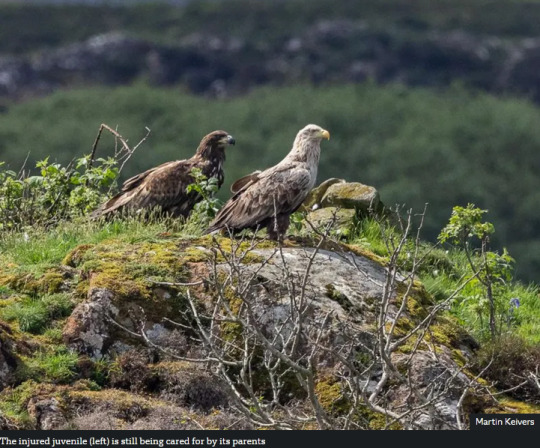
“In an unprecedented display of extended eagle parenting, the two white-tailed parents skipped this year's breeding season to continue to tend to their year-old offspring. The youngster's wing was broken when the nest fell to the ground during unseasonably wild weather last year. […] The fully-grown chick was being fed fish by its parents, caring behaviour that the eagle expert described as “unprecedented” for the birds. […] “If an immature bird was to reappear near its nesting parents or any other pair the following year [after dispersing], it would likely be aggressively chased away. That’s why this is so exceptional.””
2. Rare wild horses back on Kazakhstan’s Golden Steppe after being saved from extinction
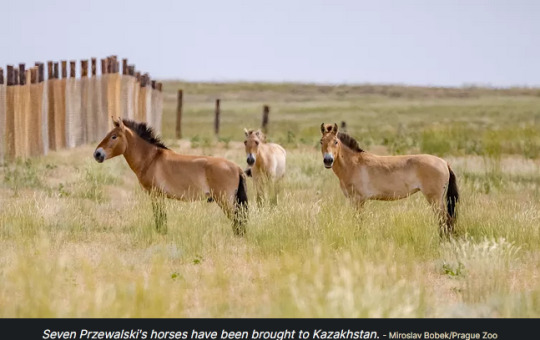
“For the first time in at least 200 years, wild Przewalski's horses have returned to Kazakhstan’s Golden Steppe. [...] Przewalski's horses are considered the last truly wild horse left on the planet as other species like the American Mustang are descended from domesticated animals. The species were once common across the vast steppes of Central Asia. [...] The zoo will also be sending some Przewalski’s to Mongolia in 2026 where a reintroduction programme has seen their population boom to well over 850 animals.”
3. For one Austin summer camp, public transit is part of the adventure

“[... “O]ver 90% of the kids will tell you that their favorite part of ATX Kids Club is riding the bus.” That’s the program’s goal: getting kids to have fun on public transit so they’ll grow up using it. The nonprofit’s summer camp, which takes kids ages 4 to 12 on field trip “adventures” around the city, uses Capital Metro buses as its main form of transportation. [...] Before camp, [the field trip leader] said, he believed in stereotypes about transit being dirty and “scary” — but his experience with Austin’s bus system has been the opposite so far.”
4. Brazil Prevents Meta from Using People to Power Its AI
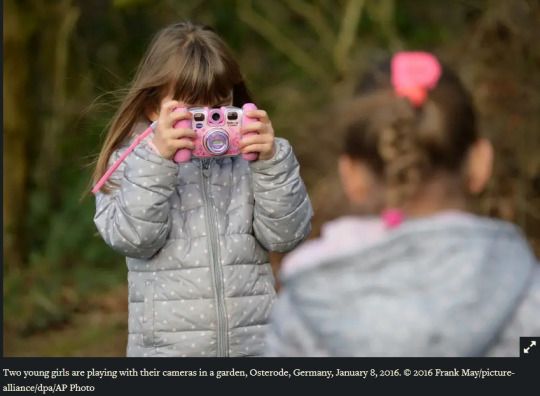
“[…P]ersonal photos of Brazilian children are used to build powerful AI tools without their knowledge or consent. In turn, others use these tools to create malicious deepfakes, putting even more children at risk of harm. […] The Brazilian government’s decision is a powerful, proactive move to protect people’s data privacy in the face of swiftly evolving uses and misuses of AI. Yesterday’s action especially helps to protect children from worrying that their personal data, shared with friends and family on Meta’s platforms, might be used to harm them in ways that are impossible to anticipate or guard against.”
5. Ambitious Living Shoreline Project Combats Coastal Land Loss in South Carolina

“Living shorelines stabilize coastlines by reducing the impacts of waves and rising sea levels. They are made of materials that promote the growth of marsh grasses and commercially important species like oysters and crabs. […C]oastal sites could offset almost 80 percent of tidal habitat loss with careful conservation and management. […] Young people in this AmeriCorps program receive training, a living stipend, an education award, and connections to potential employers.”
6. Pahranagat National Wildlife Refuge announces proposal to modernize water infrastructure

“Under the refuge’s proposal, the Service would improve 4,400 feet of an earthen water delivery ditch, rehabilitate 1,200 feet of Upper Lake Dam, develop 100 feet of new diversion channel into critical nesting habit for federally endangered southwestern willow flycatcher, modernize current water monitoring stations and improve 640 feet of the Pahranagat Ditch Drain. […] The improvements will result in significant habitat improvements for multiple bird species, [… and] also enhance flood control holding capabilities of the Upper Lake for the Pahranagat Valley.”
7. New chemical process separates textile fibers for easier recycling

“A combined team of chemical and biomolecular engineers [... have] developed a way to chemically separate fibers in textiles, allowing them to be recycled more quickly and cheaply than conventional methods. [... T]hey found they could break apart the textiles in as little as 15 minutes. They also noted that the process [breaks down polyester and spandex into] organic compound[s] that could conceivably be used to create more polyester. [... T]he material integrity of both the nylon and the cotton were retained, suggesting they could be used to make new batches of clothes.”
8. Pongamia trees grow where citrus once flourished, offering renewable energy and plant-based protein

“[Some Floridian] farmers are turning to the pongamia tree, a climate-resilient tree with the potential to produce plant-based proteins and a sustainable biofuel. […] Pongamia trees also don't need fertilizer or pesticides. They flourish in drought or rainy conditions. And they don't require teams of workers to pick the beans. […] The legume is now being used to produce several products, including Panova table oil, Kona protein bars and protein flour. The legumes also produce oil that can be used as a biofuel, largely for aviation, which leaves a very low carbon footprint[….]”
9. Trans candidate celebrates receiving more votes than anti-trans campaigner Posie Parker

“An independent trans candidate says that she hopes receiving more total votes than anti-trans campaigner Posie Parker at the general election will show trans children that they are loved. […] Bristol Central was won by Green Party’s out bisexual co-leader Carla Denyer, while Parker received just 196 votes, equal to 0.5 per cent[….] Elsewhere, trans candidate Sophie Molly secured 225 votes standing as an independent at the other end of the country, in Aberdeen South[….]”
10. Ohio zoo celebrates birth of critically endangered western lowland gorilla

“The Columbus Zoo said the gorilla was born June 29 and first-time mother Sue is "very attentive and providing excellent care to her little one, who she nuzzles and cradles closely." […] “With tiny hands and beautiful big brown eyes that melt our hearts, this baby is absolutely precious—in regard to both the cuteness factor and what the baby represents for this species’ future. We are proud of the dedication of our care teams who diligently work to provide the gorillas with top quality care and wellbeing while continuing the legacy of the Columbus Zoo’s renowned gorilla program,” said Audra Meinelt, curator of the Columbus Zoo’s Congo Expedition region.”
June 22-28 news here | (all credit for images and written material can be found at the source linked; I don’t claim credit for anything but curating.)
#good news#hopepunk#eagles#horse#endangered species#birds#public transit#children#ai#brazil#privacy#habitat#ocean#wildlife#recycling#science#farming#renewableenergy#trees#trans#transgender#uk politics#politics#civic engagement#lgbtq#zoo#gorilla#primates#baby animals
19 notes
·
View notes
Text
The Russian Revolution and the Alash Orda
It’s 1917 and Central Asia is adjusting to a Tsarless reality. To briefly recap, because a lot has already happened and it’s about to get even more complicated:
Russian settlers created the Tashkent Soviet in the city, Tashkent. It is purely Russian managed and was created in response to indigenous organizing.
Various indigenous peoples such as the Jadids, the Ulama, and even the Alash Orda spent all year organizing different organs of government, ending 1917 with the Kokand Autonomy. This is an independent state created in Kokand, a city that neighbors Tashkent, in response to the Tashkent Soviet.
The Bukharan Emir kicked out his Jadids and relied on conservative elements in his society to strengthen his hold on power before Russia returns.
The Khiva Khanate is dependent on a warlord that is planning a coup.
Up to this point, we’ve focused on an Uzbek/Tajik Jadid perspective. Today we’ll be switching focus to the Kazakh and Kyrgyz intellectuals in the Steppe and the creation of the Alash Orda government and the Autonomous Alash state.
Alash Origins
As we discussed in our interview with Dr. Adeeb Khalid, the Muslim world was going through severe soul searching in the 1900s as they tried to understand the rise of European empires and the crumbling foundation of, not just the Ottomans, but Islamic nations in general. This was true in the Kazakh Steppe as well, although for the Kazakh intellectuals, it wasn’t just a question of how does Islam survive, but how do we define Kazakhnessand how do we ensure it survives?
The Kazakh identity crisis was sparked by the land crisis. We’ve talked about this in some of our other episodes, but starting in 1890, Russian settlers streamed into the Kazakh lands, taking important arable land that the nomadic Kazakhs relied on to survive. The Russians performed several exhibitions and surveys in the region between 1890 and 1912 and the Kazakh land grew ever smaller and smaller. Of course, this came to a head in 1916 and by 1917 the Tsar was gone, Russia was in disarray, and the Kazakh peoples had an opportunity to create their own government and address land rights.
Yet, while there was a real threat from Russian incursion, the Kazakhs also took advantage of opportunities the Russian presence offered. Many Kazakhs learned Russian and went to school in Russian run schools as well as local Kazakh schools (as opposed to the madrasa education mandated in places such as Tashkent and Bukhara), they had a long history of trading and even working with Russians, and the Kazakhs were also familiar with the Tatars and even the indigenous people of the Siberian oblast that the Russians relied on to support their colonial administration. And in an odd way the land crisis brought the Kazakhs closer to their Kyrgyz and Bashkir neighbors because they were experiencing the same problem.
This connection with Siberia seems to have provided the Kazakh intellectuals the support they needed to survive Russian persecution and take their ideas and grow it into a full-fledged movement. In fact, there is a great article by Tomohiko Uyama which details how the Russia attempts to banish important Kazakh activities such as Akhmet Baitursynov and Mirjaqip Dulatov to the outskirts of the Steppe (and sometimes in Siberia itself) allowed them to make widespread connection with other activities as well as each other and only fanned the flames of their work.
Akhmet Baitursynov described this time in Kazakh society as being caught between “two fires”: the influence of Muslim culture and the influence of Russian and Western culture. Out of this tension came the Alash, modernizing intellectuals. But even the Kazakh intellectuals couldn’t decide what was the best way to save Kazakhness, so they split into two big-picture groups: the Western-centric modernizers who were the editors for the newspaper Qazaq and the Islamic-centric modernizers who were the editors for the newspaper Aiqap. Some of the most important editors of the Qazaq newspaper was Akhmet Baitursynov, who was editor-in-chief, Alikhan Bokeikhanov, and Myrzhaqyp Dulatov, and they would go forth to become key members of the future Alash state. Some of the most important editors of the Aiqap newspaper were Mukhamedzhan Seralin, Bakhytzhan Qaratev, and Zhikhansha Seidalin.
What was the Alash platform? The two key pillars of their platform were land rights and preserving Kazakh identity.

Akhmet Baitursynov, Alikhan Bokeikhanov, and Myrzhaqyp Dulatov
[Image Description: An image of three Asian men sitting together. The man on the left has short black hair and a droppy mustache. He is wearing glasses and a white shirt, black tie, and black suit. The man in the middle has shaved black hair and a heavy mustache. He is also wearing a white shirt, black tie, and black suit. The man on the right has black hair and thin mustache. he is wearing a white shirt, a black bowtie, and a grey suit.]
Land Rights
We’ll start with land rights, because that is why really differentiates the Steppe from the rest of Central Asia. As we mentioned, the Russians were taking Kazakh land, and making land ownership dependent on one’s sedentary behavior. The Russians also published numerous pieces of propaganda belittling nomadic life. So, the Kazakhs had to determine whether to maintain their nomadic lifestyle or adopt a sedentary lifestyle.
Bokeikhanov, an editor of Qazaq newspaper, argued that the Russians wanted the Kazakh to settle down so they could give even more land (and most certainly the best land) to the Russians while giving the useless land to the Kazakhs and then blaming them for failing. Baitursynov picked up that argument and pointed out that the Kazakhs could not succeed unless they first learned how to farm, but the Russians weren’t interested in that aspect of sedentary life at all. They just pushed the Kazakhs to settle down and worry about the rest later. This could have come out of Russia’s (and the Tatar’s) lack of knowledge of the Kazakh situation but could have also been purposeful ignorance.
Bokeikhanov and Baitursynov argued for a gradual transition to sedentarization due the Steppe’s climatic conditions and lack of agricultural knowledge otherwise they would risk starvation (which Stalin proved in the 1930s). In a series of article, they argued that:
“If we ask what kind of economy is more suitable for Kazakhs-the nomadic or the sedentary-the question is incorrectly posed. A more correct question would be: what kind of economy can be practiced under the climatic conditions of the Kazakh steppe? The latter vary from area to area and mostly are not suitable for agricultural work. Only in some northern provinces do the climatic conditions make it possible to sow and reap. The Kazakhs continue wandering not because they do not want to settle down and farm or prefer nomadism as an easy form of economy. If the climatic conditions had allowed them to do so, they would have settled a long time ago.” - Gulnar Kendirbai, '"We are Children of Alash...", pg. 9
Displaying a better understanding of the science behind climate and agriculture than the Russians or the Soviets that would follow, the editors argued that the climate was the number one factor in nomadism and the Kazakhs could not become sedentary until they learned how to adjust to the demands of the land. Another article argued that sedentarism would lead to failed farming which would lead to wage work which led to great abuses and a higher chance of being converted to Christianity, so the Kazakhs must also learn handicrafts in addition to science. They described the Russian’s disinterested in their arguments as
“One may compare it with the dressing some Kazakh in European fashion and sending him to London, where he would either die or, in the absence of any knowledge and relevant experience, work like a slave. If the government is ashamed of our nomadic way of life, it should give us good lands instead of bad as well as teach us science. Only after that can the government ask Kazakhs to live in cities. If the government is not ashamed of not carrying out all the above-mentioned measures, then the Kazakhs also need not be ashamed of their nomadic way of life. The Kazakhs are wandering not for fun, but in order to graze their animals.” - Gulnar Kendirbai, '"We are Children of Alash...", pg. 10
It should be noted that the Alash did not equate nomadism with Kazakh identity. Instead, they argued that the Kazakhs (and I would argue extend that to the Kyrgyz and Bashkirs) were nomadic for a sensible and scientific reason and if the Russians were truly interested in helping the Kazakhs successfully transition to sedentarism, then they needed to provide the tools otherwise they were setting the Kazakhs up for failure.
Mukhamedzhan Seralin, an editor of the Aiqap newspaper, believed that the sooner the Kazakhs settled down the sooner they could gain a European level education and become competitive in the modern world while increasing the role of Islam in Kazakh society. He argued that:
“We are convinced that the building of settlements and cities, accompanied by a transition to agriculture based on the acceptance of lands by Kazakhs according to the norms of Russian muzhiks, will be more useful than the oppose solution. The consolidation of the Kazakh people on a unified territory will help preserve them as a nation. Otherwise, the nomadic auyls will be scattered and before long lose their fertile land. Then it will be too late for a transition to the sedentary way of life, because by this time all arable lands will have been distributed and occupied.” - Gulnar Kendirbai, '"We are Children of Alash...", pg. 10
The editors of Aiqap argued with the others on the need for greater education, various options for work, etc., but they believed that the Kazakhs could never have these things untilthey became sedentary whereas the editors of Qazap believed that the Kazakhs could not become sedentary until they had those things.
Kazakh identity
This leads to the second pillar in the Alash platform: preserving Kazakh identity.
For the Kazak intellectuals of all stripes, the second most important element of Kazakh society was education and literature. They were worried about the poor education opportunities that centered Kazakhness instead of Russianness, available to Kazakh children. Even after primary school, the Kazakh educational options were limited: either they try to get accepted into a madrassa or go to Russia for further education. The Kazakh intellectuals learned of the new teaching methods the Jadids championed via their southern neighbors as well as the Tatars in the area and used literature to encourage the Kazakh people to focus on schooling.
Akhmet Baitursynov was focused on reforming primary schools and the lack of teaching materials, especially on the Kazakh language. The Qazap newspaper was the only newspaper who wrote in pure Kazakh. Baitursynov answered their detractors as followed:
“Finally, we would like to tell our brothers preferring the literary language: we are very sorry if you do not like the simple Kazakh language of our newspaper. Newspapers are published for the people and must be close to their readers.” - Gulnar Kendirbai, '"We are Children of Alash...", pg. 19
The Kazakh intellectuals resisted the Tatar clergy’s attempts to subsume Kazakh language to the Tatar language, eventually arriving at a compromise. This pressure around language inspired Akhmet Baitursynov to reform the Kazakh language, creating spelling primers, and improving the Kazakh alphabet multiple times. This book was soon used in primary schools. He also published a textbook on the Kazakh language which studied the phonetics, morphology, and syntax of the Kazak language as well as a practical guide to the Kazakh language and a manual of Kazakh literature and literary criticism.
Meanwhile Bokeikhanov focused on creating a unified Kazakh history, believing that “History is a guide to life, pointing out the right way.” Together Bokeikhanov and Baitursynov focused on collecting Kazakh folklore, the history of their cultures and traditions, and shared world history with other Kazakhs through their newspapers. They encouraged Kazakh writers to write down their poems and stories, fearful that they would be lost if Kazakhs stuck purely to an oral tradition.
For intellectuals like Bokeikhanov and Baitursynov, Kazakhness was connected to a cultural identity as opposed to a religious identity. Bokeikhanov supported the idea of separation between religion and state and resisted the Aiqap’s call for introduction to Sharia law. Bokeikhanov believed that they should codify and record Kazakh laws, customs, and regulations to counter corruption and bribery, instead of relying on Sharia law. The Kazakh people had a different relationship to Islam than the other peoples of Central Asia (which may have been why the Russian missionaries were initially confident the Kazakhs would be easiest to convert). While the editors of Aiqap believed that sedentary life would create closer ties to Islam, the editors of the Qazap newspaper believed that Islam was a part of Kazakh society but didn’t equal Kazakh society.
1905 Russian Revolution
We’ve talked quite a bit about what the Alash stood for, but how did this translate into political action? The Kazakhs, like many other Central Asians, were initially excited about the 1905 Revolution, which created a State Duma that “welcomed” Central Asians as members for about two Dumas. When the Kazakhs could participate, they sent Alikhan Bokeikhanov and Mukhamedjan Tynyshpaev.
After the Second Duma, the Kazakhs were no longer permitted to send their own deputies, so they either had to rely on the Tatar deputies of the Muslim Faction of the Russian Duma or find support elsewhere. The Kazakh intellectuals believed that the Tatars had no real knowledge of Kazakh needs and distrusted them. So, they turned to the Russian Constitutional-Democratic Party i.e., the Kadets.
The Kadets sold themselves as an umbrella party that advocated for civil rights, cultural self-determination, and local legislation that would allow for the use of native languages at schools, local courts, administrations, and institutions. Even though the Kadets and the Alash didn’t agree on land rights, they still became allies. The tension between the two parties would not disappear, especially following the 1916 Revolt (which the Alash, like the Jadids, tried to prevent), but they also acknowledged that the Kadets were the only game in town.
1917 Russian Revolution
The 1917 Revolution changed all of that by allowing the indigenous peoples and settlers to create their own forms of government. In April 1917, they would form their own All-Kazakh Congress in Orenburg where they passed a resolution calling for the return of Steppe land to Kazakh peoples, control over local schools, and the expulsion of all new settlers in Kazakh-Kyrgyz territories.
The Alash used 1917 to win local support, focusing on winning the support of the most influential leaders of the local communities and trusting the elders to use tribal affiliations to mobilize the people under the Alash banner. The Kazakh intellectuals dug deep into Kazakh history to unify the people under Alash, the father of all Kazakhs, creating a unified history from creation to modernity. This can be thought of as similar to the Jadids attempts to trace Uzbekness back to Timur.
They also worked with the Provisional Government in Russia, and with the various councils and meetings held by their Jadid counterparts in Turkestan, but ran into great friction because their Tatar, Uzbek, Tajik, etc. counterparts didn’t truly appreciate how important the land issue was for the Kazakhs. They were also wary of the Ulama’s version of a council, wanting to maintain the traditionally limited role of Islam in Kazakh society.
Because of the differences in priorities and the role of Islam, the Alash would go their own way while continuing to support the efforts of other indigenous peoples. They would continue to serve on the various councils and even took part in the creation of the Kokand Autonomy, but knew they needed their own Congresses and their own autonomous state to protect their people and achieve meaningful land reform.
The Kokand Autonomy created three seats for Alash members, believing that two southern Kazakh oblasts would be part of the Kokand Autonomy whereas the Alash wanted a unified Kazakh state. Bokeikhanov explained the Alash’s position as follows:
“Turkestan should first become an autonomy on its own. Some of our Kazakhs argue it would be correct to join the Turkestanis. We have the same religion as the Turkestanis, and we are related to them. Establishing an autonomy means establishing a country. It is not easy to lead a country. If our own Kazakhs leading the country are unfortunate, if we make the argument that Kazakhs are not enlightened, then we can argue that the ignorance and lack of skill among the people of Turkestan is 10 times higher than among Kazakhs. If the Kazakhs join the Turkestani autonomy, it would be like letting a camel and a donkey pull the autonomy wagon. Where are we headed after mounting this wagon?” - Ozgecan Kesici, 'The Alash Movement and the question of Kazakh ethnicity', 1145
The Alash similarly considered joining the Siberian Autonomy movement but broke away once more over the issue of Kazakh autonomy. As Bokeikhanov explained:
“In practice, the autonomy of our Kazakh nation will not be an autonomy of kinship, rather, it will be an autonomy inseparable from its land.” - Ozgecan Kesici, 'The Alash Movement and the question of Kazakh ethnicity', 1146
Failing to find neighbors who would respect their autonomy and facing extreme violence because of the Russian Civil war that was working itself way through Siberia, the Alash would proclaim the creation of the Alash Autonomy during the Second All-Kazakh Congress in December 1917. This would be the first time a Kazakh state existed since the Russian invasion in 1848. This autonomous state would be ruled by the Alash Orda, a government made up of many of the modernizing intellectuals who worked at the Qazap and Aiqap newspapers. Alikhan Bokeikhanov was elected its president. Whatever relief they may have felt at creating a state government must have been quashed by the understanding that civil war was at the Steppe’s door and sooner or rather they would have to choose a side and risk their long fight for autonomy.
References
'Challenging Colonial Power: Kazakh Cadres and Native Strategies' by Gulnar Kendirbai, Inner Asia 2008, Vol 10 No 1
'"We are Children of Alash..." The Kazakh Intelligentsia at the beginning of the 20th century in search of national indeitty and prospects of the cultural survival of the Kazakh people' by Gulnar Kendirbai, Central Asian Survey, 1999, Vol 18 No 1
'The Alash Movement and the question of Kazakh ethnicity' by Ozgecan Kesici, Nationalities Papers, 2017, Vol 45 No 6
'Repression of the Kazakh Intellectuals as a sign of weakness of Russian Imperial Rule'by Tomohiko Uyama Cahiers du Monde russe 2015 Vol 56, No 4
Making Uzbekistan: Nation, Empire, and Revolution in the Early USSR by Adeeb Khalid
Russia and Central Asia: Coexistence, Conquest, Coexistence by Shoshana Keller Published by University of Toronto Press, 2019
#history blog#season 2: central asia#central asian history#central asia#kazakhstan#qazaqstan#qazaq history#kazakh history#alikhan bukeikhanov#Akhmet Baitursynov#Spotify
4 notes
·
View notes
Text
How to Identify Cross Orbweaver Spiders
Originally posted on my website at https://rebeccalexa.com/how-to-identify-cross-orbweaver-spiders/. Click here to learn more about the How to Identify article series.
Name: Cross orbweaver spider (Araneus diadematus), also known as cross spider, European garden spider, et. al.
Range and typical habitat(s): Native to much of Europe, sporadically found in temperate areas of Asia, introduced to North America, particularly the west coast and northeast United States.
Distinguishing physical characteristics (size, colors, overall shapes, detail shapes) and behaviors: Fall is just around the corner, and if you’re looking for more eco-friendly seasonal decorations, the cross orbweaver is the perfect fit! While these spiders have spent all summer chowing down on insects, by September they’ve gotten big enough to be quite visible on their large orb webs.
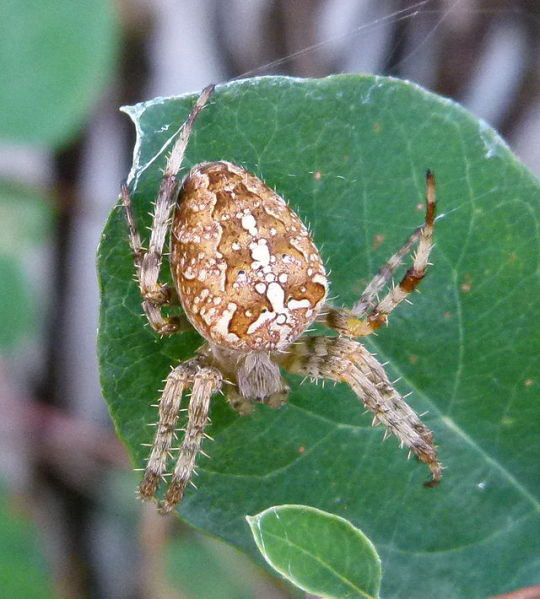
A mature female cross orbweaver spider.
Both sexes are a variable combination of orange, yellow, brown, and/or gray, and they all have white cross-shaped markings on the dorsal (upper) side of their rather large, oval-shaped abdomens. The legs are tan to orange with darker brown or gray stripes. Like many other web-weaving spiders, cross orbweavers tend to rest in the center of their web with their head facing down and their legs flexed rather than straight, though the fourth pair in the back may sometimes be extended somewhat. Their legs are covered in fine hairs with a fuzzy appearance. They are also known to perch on nearby leaves and twigs.
Like other members of the family Araneidae, the orb-weavers, these spiders have four pairs of eyes. Females are larger than males, reaching up to 1″ long in exceptional individuals, while males usually top out at 1/2″ or less. A close examination shows that males can also be distinguished by large pedipalps with swollen ends. These are little appendages nestled between the chelicerae (jaws) and the first pair of legs. Males use the pedipalps in mating displays, and to also pass sperm to the female. A courting male needs to be careful, as females will engage in cannibalism.
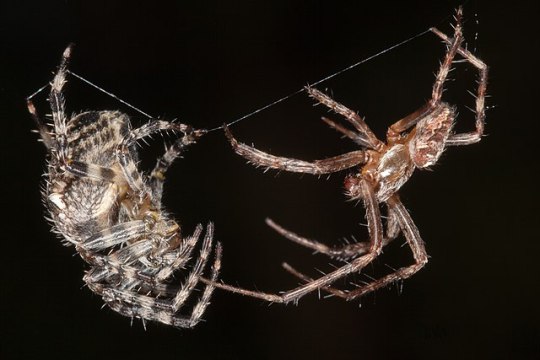
A male cross orbweaver (right) carefully approaches a female (left) with the intent to mate.
The eggs laid by females the previous fall hatch in spring, releasing several dozen (or more!) tiny yellow spiderlings into the world. While they make webs as soon as they find a good location, these young spiders often end up as prey for other animals themselves. Cross orbweavers generally live no more than a year, though females die shortly after laying their eggs, and males are often eaten by their mates.
The web is made of a series of overlapping threads of silk like the spokes in a wheel, with a spiraling orb starting at the center and working its way outward. A cross orbweaver’s web may be quite large, and the central orb may at times exceed two feet in diameter. They are not picky about where they set up shop, and are often found near homes and other buildings, where they are quite adept at catching flying insects that blunder into the web. If threatened, these spiders shake their web vigorously, and are not prone to bite unless handled roughly. They may dry bite in self-defense, choosing not to use venom. Their venom is not considered dangerous to humans.
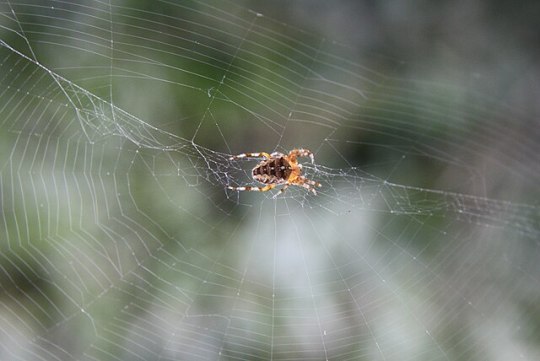
Other organisms it could be confused with and how to tell the difference: There are several other Araneus species that look quite similar to the cross orbweaver. Of these, the most similar is the four-spot orbweaver (Araneus quadratus) has less variegated orange, green, or brown abdomen with four small white spots on it rather than a cross, though they have similarly striped legs. It is found only in Europe.
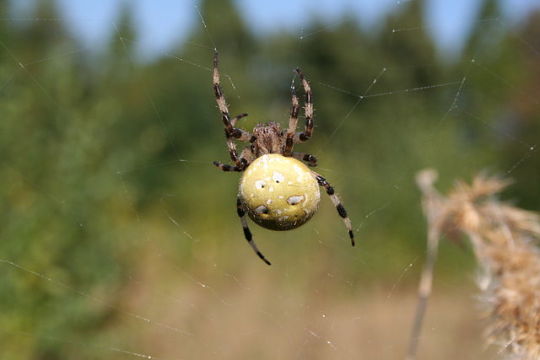
Araneus quadratus
The cat-faced spider (Araneus gemmoides), also known as the jewel orbweaver, is of similar size and color variation to the cross orbweaver. However, its abdomen has two pronounced points on top that look rather like a cat’s ears. Araneus gemma (not pictured) is also sometimes called the cat-faced spider or the gem-shaped spider, and it has a similarly shaped abdomen but tends to be paler in color. Both of these species are primarily found in the western half of temperate North America.
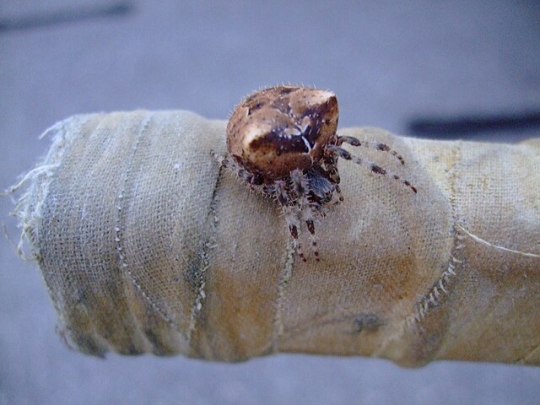
Araneus gemmoides. By Trucmuche04, CCA-SA-3.0
Anything else worth mentioning? Because the cross orbweaver is not native to North America, it competes with native spiders for food. This is especially concerning as insect populations have plummeted in recent decades due to pesticide use and habitat loss. It is often found in urban areas and other places with lots of human habitation, and is considered an invasive species in the Bay Area. They are considered harmless to humans.
Further Reading:
Cross Orbweaver Spider
Cross Orbweaver
Cross Orbweaver (Araneus diadematus)
Spiderspotter: Cross Orbweaver
Did you enjoy this post? Consider taking one of my online foraging and natural history classes or hiring me for a guided nature tour, checking out my other articles, or picking up a paperback or ebook I’ve written! You can even buy me a coffee here!
#spider#spiders#cw spiders#spider tw#cross orbweaver#orb weaver#arachnids#arthropods#invertebrates#bugs#wildlife#animals#wild animals#nature#nature identification#invasive species#biodiversity#science#scicom
56 notes
·
View notes
Text

Autumn in Northern Mongolia
Autumn arrived in a blaze of color in north-central Mongolia. The montane forests surrounding Lake Hövsgöl, the country’s largest lake by volume, took on golden hues in late September 2024, while high mountain ridges nearby sported a layer of bright white snow.
At an elevation of 1,645 meters (5,397 feet), Lake Hövsgöl (also known as Khuvsgul and Khövsgöl) sits at the foot of the eastern Sayan Mountains, near the border with Russia. Along with shrubs and grasslands, forests consisting primarily of Siberian larch (Larix sibirica) blanket the hills around the lake. Larches are deciduous conifer trees, meaning that they have cones and needles like conifers, but they change color and drop their needles in the fall like deciduous trees.
The result of this seasonal transformation was captured by the OLI (Operational Land Imager) on Landsat 8 on September 26 (above, right). For comparison, an image acquired about one month earlier by the OLI-2 on Landsat 9 (left) shows much greener vegetation.

Lake Hövsgöl, which has existed for over 2 million years, is one of the world’s ancient lakes. It measures approximately 137 kilometers (85 miles) from north to south and is an important water resource for Central Asia, holding about three-quarters of Mongolia’s freshwater. Researchers have described the lake as “near-pristine,” with minimal development in its watershed. Its waters are oligotrophic, or low in nutrients, and very clear. The only outlet from Lake Hövsgöl ultimately feeds into the much older and larger Lake Baikal, about 200 kilometers (125 miles) to the east.
Fall is a relatively short season in this part of northern Mongolia. Ice can start to form on Lake Hövsgöl as early as November and persist into June. Reaching thicknesses up to 1.5 meters (5 feet), the ice once supported truck routes across the lake. Driving on the ice has been prohibited for decades due to environmental concerns, and efforts are underway to retrieve vehicles that sank while attempting the crossing.
NASA Earth Observatory images by Wanmei Liang, using Landsat data from the U.S. Geological Survey. Story by Lindsey Doermann.
7 notes
·
View notes
Text
fav animals #1
been thinking about doing this for a while now so we here we go :3
Snow Leopards!1!1!!

Did you know snow leopards are more closely related to tigers than they are to leopards? How misleading!
Taxonomic Info
Uncia uncia (also sometimes referred to as Panthera uncia.)
Kingdom: Animalia
Phylum : Chordata (animals that possess a notochord.)
Subphylum: Vertebrates (animals that possess a backbone or vertebrae.)
Class: Mammalia (mammals like us!)
Order: Carnivora (organisms that consume primarily meat.)
Family: Felidae (cats.)
Genus: Uncia (snow leopard.)
Geographic Range
Snow leopards are distributed throughout high mountain ranges in Central Asia, particularly the Himalayan mountain system. They have been found in Bhutan, Nepal, and the Siberian region of Russia. About 60% of their range occurs in China!
Habitat
Snow leopards live in temperate regions, and prefer to sleep in steep, rocky and broken terrain. Cliffs and ridgelines are also fair game. They live in elevations of 900 to 5500 meters or higher. (2952.76 ft - 18044.62). In winter, snow leopards migrate to lower elevations to follow their prey. They tend to generally avoid dense forest cover and cultivated fields.

Did you know snow leopards are referred to as "ghosts of the mountains" due to their reclusivity? Spooky!
Physical Description
One curious thing about snow leopards is how long their tails are! Their tails equal to roughly 75% to 90% of their total body length! These long tails are used for balance in their rocky and steep homes, and can also be used to cover their extremities in harsh winters. Their average weight is around 35 to 45 kg (77 lbs - 99 lbs). They have no pronounced sexual dimorphism, though males may be slightly larger in general. Snow leopards have characteristically large paws compared to other cats. These adorable large paws are an adaptation for walking on snow. They also have relatively long hind legs that are adapted for agility and jumping ability. Snow leopards have long and thick coats that shed twice per year, and yield a thicker coat during the winter. Their small rounded ears are an adaptation to minimize heat loss in their cold environments. In comparison to other cats, snow leopards have much larger nasal cavities, and smaller heads relative to body size.

Snow leopards can't actually roar, so they often chuff and make other calls instead!
Reproduction
Snow leopards are solitary, and do not associate with mates unless its mating season. Since it takes a long time to rear cubs, female snow leopards mate every 2 years. They are polygynous (males mate with more than one female.) in the wild, but some captive snow leopards are known to have become monogamous. After a pregnancy of about 90-105 days, a litter consisting of 2-3 cubs is born. (1 to 5 cubs can also occur.) They are born blind and in a warm nest made from their mothers underbelly fur. As most mammals, they feed on milk from their mother until they are about 5 months old. For roughly their first year of life, snow leopard cubs are dependent on their mother.

Did you know snow leopards cubs are undeniably adorable?
Lifespan
Since snow leopards are so hard to find and record, its difficult to determine their average lifespan in the wild. It's thought to be 10 to 12 years. Captive snow leopards have lived for up to 25 years, though the average is 18 years.
Behavior
Snow leopards are crepuscular, meaning they are most active at dawn and dusk. They are highly mobile and move from one location to another on a daily basis. Due to their elongated legs and large paws, they have excellent jumping abilities, and can climb pretty well. Their preferred method of hunting is to stalk and then ambush their prey from above, using rocky terrain and shrubby vegetation to conceal themselves. Snow leopards generally avoid one another, and mark travel lanes by using scent and scratches on trees.

Did you know snow leopards can jump as high as 50 feet? How acrobatic!
Food Habits
Snow leopards are active hunters, and are opportunistic predators. They are capable of killing animals more than three to four times their own weight, but will also settle for much smaller prey in harsher times. The primary prey species of snow leopards are blue sheep. Other prey species include ibexes, markhors, argali sheep, urials, Himalayan tahrs, serows, gorals, musk deer, wild boar, Tibetan antelope, Tibetan gazelles, goitered gazelles, wild donkeys, and wild yaks. Smaller prey include marmots, hares, pikas, voles, mice and birds. Snow leopards have few natural predators other than humans, though interspecific killing between leopards and snow leopards can occur.
Conservation Status
Snow leopards are endangered, and in the past 2 decades, populations of snow leopards are suspected to have declined by 20% due to habitat loss, prey loss, poaching, and persecution. They are commonly poached for their beautiful pelts and their bones. You can learn and help snow leopards here!: https://snowleopard.org
Personal Opinion
-Very pretty kitties -Love their coats -Adorable -10/10
4 notes
·
View notes
Text
Garlic Folklore
Allium sativum

Ruled by ♂
⸙༄𓆤𓆩𓆪❁𓇢𓆸🏵
Contents:
Overview
Folklore
Uses in Witchcraft
Safety Notes
Conclusion
⸙༄𓆤𓆩𓆪❁𓇢𓆸🏵
Overview
This beloved seasoning is native to Central Asia and northeaster Iran. There are many subspecies grown in food gardens worldwide and used for many different purposes. There are two types of Allium sativum, hard neck and soft neck. Hard neck garlic does better in colder climates and is harvested, not only for the bulb, but also the scapes. Soft neck tends to grow better in warmer climates and is ideal for making braids.
Planted after the first frost, garlic has historically been used for food, medicine, and magic. It is ready for harvest when the leaves begin to wilt.
⸙༄𓆤𓆩𓆪❁𓇢𓆸🏵
Folklore
The folklore here is included because not all witches are of European descent and I wish to be inclusive. Please be respectful of cultures which are not your own.

-Legend of Tangun-
A bear ate only a bundle of mugwort and 20 cloves of garlic for 100 days, while avoiding sunlight the whole time, to become a beautiful human woman. She gave birth to the founder of Korea.

-Hecate's Suppers-
Garlic wreaths are one of the many offerings given at the new moon crossroads suppers of the cthonic goddess Hekate.

-Vampires-
Rubbed on the heads of children in China and malaysia, slavic countries hang them in braids and wear them around the neck. They also stuffed corpses mouths with them and poured them into suspected vampires’ mouths after staking them through the heart or decapitating them (the corpse). (Information was found in a book titled "In Search of Dracula: The History of Dracula and Vampires" which is, unfortunately, no longer available on Archive.org where I originally found it.)
⸙༄𓆤𓆩𓆪❁𓇢𓆸🏵
Uses in Witchcraft
A protective plant against death and spirits. One effective way is to braid them together, asking for their protection, and hang above a doorway or on the doorknob. You can also add cloves to food or jars/bags when dried. Powdered garlic may work in powder formulations for banishings and general protection. It's also a common ingredient in Four Thieves Vinegar which is good for cleaning, magical and mundane.
⸙༄𓆤𓆩𓆪❁𓇢𓆸🏵
Safety Notes
Those with gastrointestinal sensitivities or ulcers may find that garlic aggravated their condition. Use only culinary amounts if on blood thinner or during pregnancy, in the postpartum period, and during lactation. Avoid 2 weeks before and after surgical procedures.
⸙༄𓆤𓆩𓆪❁𓇢𓆸🏵
Conclusion
While garlic is not a native plant for me, it is one that I grow every year in the garden and that I'm planting right now. Ironically it also keeps rabbits and other animals away from my spring seedlings. Protective all around then! What do you like to use garlic for?
References:
Excerpts from Iryon's Memorabilia of the Three Kingdoms (Samguk Yusa): The Tangun Legend
Hekate Garlic
Virgil's Aeneid <- more on Hekate
The Herbal Academy's Intermediate Course Herbal Monograph
Images:
Title image made on Canva
Dangun by Jacques Beaulieu
Hecate by Maximillian Pirner
Covert from the Rider edition of Brom Stoker's Dracula by Edgar Alfred Holloway
4 notes
·
View notes
Text
[yes, i am aware this is a weird rambling, please let me vent]
One toh-related fear is that the writers will eventually reveal that the story with Hunter and previous Golden Guard was only given to Darius after the shortening, and initially Hunter's story was connected solely to the Clawthornes (and i feel like it is fairly likely if season 2-3a structure was significantly different before shortening; especially since the writers did say there was a plan for Hunter to stay in the Owl House, and there were hints that their connections would be important like the way he did his 'Bye' thing in the same episode Eda did it, the connection between Dell's palisman and Flapjack&Waffles etc. Afterall if they could reuse Lilith's outfit concept design for Darius, why not shove an unused storyline at him too).
And i admit that it might have been neater plot-wise, and i also admit that my dislike of it is mainly because of the fandom's reaction towards Darius. Because the fandom can't be normal about Darius, whether he is demonized or treated as a prop that dispenses comfort. So if he wasn't meant to be involved in Hunter's development, then it is almost certain that the fandom would turn on him with even more vindictiveness or dismiss his character all together. It wouldn't surprise me if even Camila would be dropped as a parental figure for Hunter because of the racist fanon hierarchy. Fandom at large would not care about Darius's and Hunter's development that was actually shown in the aired episodes (i mean people are already viciously denying that Hunter was happy to see Darius in s3), even when other changes that happened because of the shortening are accepted as absolute canon. Fandom at large would not think how that sudden change in the plot could have affected the way Darius was written in ASiAS either.
And almost certainly most of the fandom would not care about the story that Darius might have had initially, pre-shortening: because if you believe Dana's words that he was always meant to be a good guy, then he might have had an interesting - but different - story before the changes, maybe even with more focus on just his own character. But it won't matter for the Hunter-focused fandom. And being Darius's fan would become even more unbearable. (Also, yes, i just don't want to see vindicated all those Lilith fans who have been whining from the very beginning how the previous GG should have been her mentor instead of Darius', and how she should have had the plot with Hunter)
But then I also don't really like what it would mean for Eda and Lilith and the Owl House dynamics. I don't like that it would turn Hunter into an even more central and important character and firmly place him into the Owl family, and in fandom's eyes that would definitely mean replacing King. Meanwhile, considering the way s2a was written, it is not even guaranteed that Willow and Gus would have had more screentime without the shortening or that they would have been allowed to have more development with Luz, Eda and King (even though with all of them they had dynamics in s1). So it would just make the character focus even more uneven.
And i understand that the current Clawthornes are far enough removed from Evelyn that you might say that Hunter being taken in by them is more like a found family than biolgical family, and would be more of a story about reconnecting with one's heritage, but still. It would feed right into "Eda is everyone's mom!" fanon that i really dislike. Yes, she adopted King, and she has found family dynamic with Luz, but, imo, that's enough. I think her journey to opening up and building community and mentoring children who are not related to her is way is more important and interesting (even if i don't like that Edric was prioritized over, for example, Gus; and i still have mixed feeling over her opening her own school). Even her mentoring Hunter would have been interesting if it had grown from the Eclipse Lake interactions rather than her basically adopting him. And if not Eda then Lilith would have had to become parental towards him - and i really don't like that either. Fanworks set in AUs are one thing, but it's nice that at least one woman in the cast doesn't want to be a mother, and that is shown to be ok. She can be a weird aunt, and maybe even a mentor again for Amity. Oh, you might say, but why do you think that she or Eda would have to be Hunter's parent if they had a plot together, when she can just be an aunt/mentor for him too? Well, this is my weird rant, but also why him over Luz, Amity and King? I just don't think that even with full 3 seasons the show would have had time to explore the characters evenly and Hunter would have been over-prioritized.
Though, i admit, one idea that i like is that after the HM Hunter might have stayed in the Owl House while Luz would have somehow end up with the rebels and had an episode or several with them (since her meeting with Raine was meant to be a bigger thing initially). That would have been nice (and i am going to put it in a separate post so you don't need to reblog it together with this)
#toh rant#darius deamonne#toh darius#not tagging the others because their fans probably would prefer the version i am ranting about and this is my weirdo rant time#toh speculation#long post
4 notes
·
View notes